RENAULT KADJAR 2018 Owners Manual
Manufacturer: RENAULT, Model Year: 2018, Model line: KADJAR, Model: RENAULT KADJAR 2018Pages: 310, PDF Size: 8.35 MB
Page 101 of 310
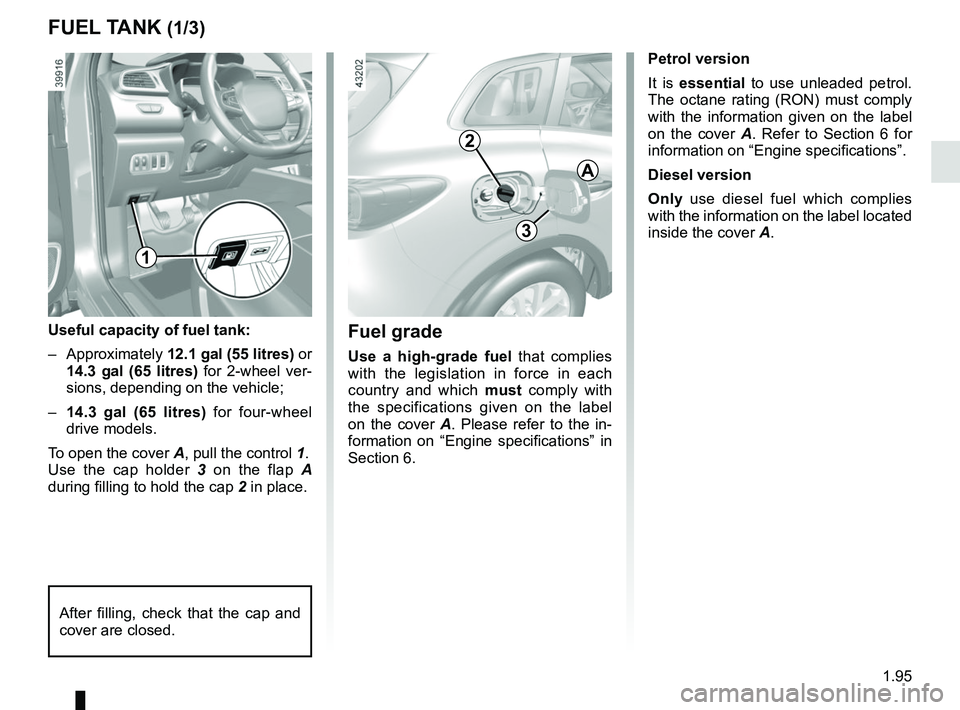
1.95
FUEL TANK (1/3)
A
3
2
Fuel grade
Use a high-grade fuel that complies
with the legislation in force in each
country and which must comply with
the specifications given on the label
on the cover A. Please refer to the in-
formation on “Engine specifications” in
Section 6.
Useful capacity of fuel tank:
– Approximately 12.1 gal (55 litres) or
14.3 gal (65 litres) for 2-wheel ver-
sions, depending on the vehicle;
– 14.3 gal (65 litres) for four-wheel
drive models.
To open the cover A, pull the control 1.
Use the cap holder 3 on the flap A
during filling to hold the cap 2 in place.
After filling, check that the cap and
cover are closed.
Petrol version
It is essential to use unleaded petrol.
The octane rating (RON) must comply
with the information given on the label
on the cover A. Refer to Section 6 for
information on “Engine specifications”.
Diesel version
Only use diesel fuel which complies
with the information on the label located
inside the cover A.
1
Page 102 of 310
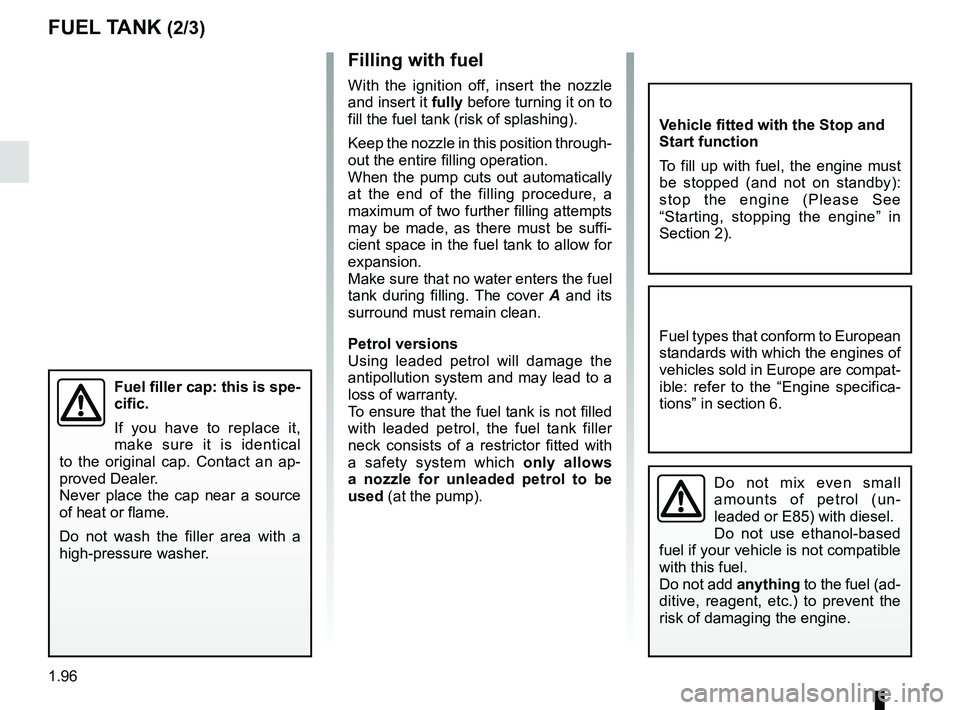
1.96
FUEL TANK (2/3)Filling with fuel
With the ignition off, insert the nozzle
and insert it fully before turning it on to fill the fuel tank (risk of splashing).
Keep the nozzle in this position through-
out the entire filling operation.
When the pump cuts out automatically
at the end of the filling procedure, a
maximum of two further filling attempts
may be made, as there must be suffi-
cient space in the fuel tank to allow for
expansion.
Make sure that no water enters the fuel
tank during filling. The cover A and its
surround must remain clean.
Petrol versions
Using leaded petrol will damage the
antipollution system and may lead to a
loss of warranty.
To ensure that the fuel tank is not filled
with leaded petrol, the fuel tank filler
neck consists of a restrictor fitted with
a safety system which only allows
a nozzle for unleaded petrol to be
used (at the pump).
Vehicle fitted with the Stop and
Start function
To fill up with fuel, the engine must
be stopped (and not on standby):
stop the engine (Please See
“Starting, stopping the engine” in
Section 2).
Fuel filler cap: this is spe-
cific.
If you have to replace it,
make sure it is identical
to the original cap. Contact an ap-
proved Dealer.
Never place the cap near a source
of heat or flame.
Do not wash the filler area with a
high-pressure washer.
Fuel types that conform to European
standards with which the engines of
vehicles sold in Europe are compat-
ible: refer to the “Engine specifica-
tions” in section 6.
Do not mix even small
amounts of petrol (un-
leaded or E85) with diesel.
Do not use ethanol-based
fuel if your vehicle is not compatible
with this fuel.
Do not add anything to the fuel (ad-
ditive, reagent, etc.) to prevent the
risk of damaging the engine.
Page 103 of 310

1.97
FUEL TANK (3/3)
Persistent fuel odour
If you notice a persistent
fuel odour you should:
– stop the vehicle as soon as traf- fic conditions allow and switch off
the ignition;
– switch on the hazard warning lights and ask your passengers to
leave the vehicle and stay clear
of the traffic;
– contact an approved Dealer.
No modifications what-
soever are permitted on
any part of the fuel supply
system (electronic units,
wiring, fuel circuit, injectors, pro-
tective covers, etc.) as this may be
dangerous (unless undertaken by
qualified Network personnel).Running out of fuel on diesel
versions
Vehicles with key/remote control
– Put the ignition key in “On” posi- tion M (please see the information
on the “Ignition switch” in Section
2) and wait for a few minutes before
starting, to enable the fuel circuit to
be primed;
– turn the key to position D . If the
engine does not start, repeat the pro-
cedure.
– If the engine does not start after sev- eral attempts, please contact an au-
thorised dealer. Vehicles with RENAULT card
With the card RENAULT
in the pas-
senger compartment, press the start
button 4 without pressing any of the
pedals. Wait a few minutes before start-
ing. This will enable the fuel circuit to
be primed. If the engine does not start,
repeat the procedure.
If the engine does not start after several
attempts, please contact an authorised
dealer.
4
Page 104 of 310
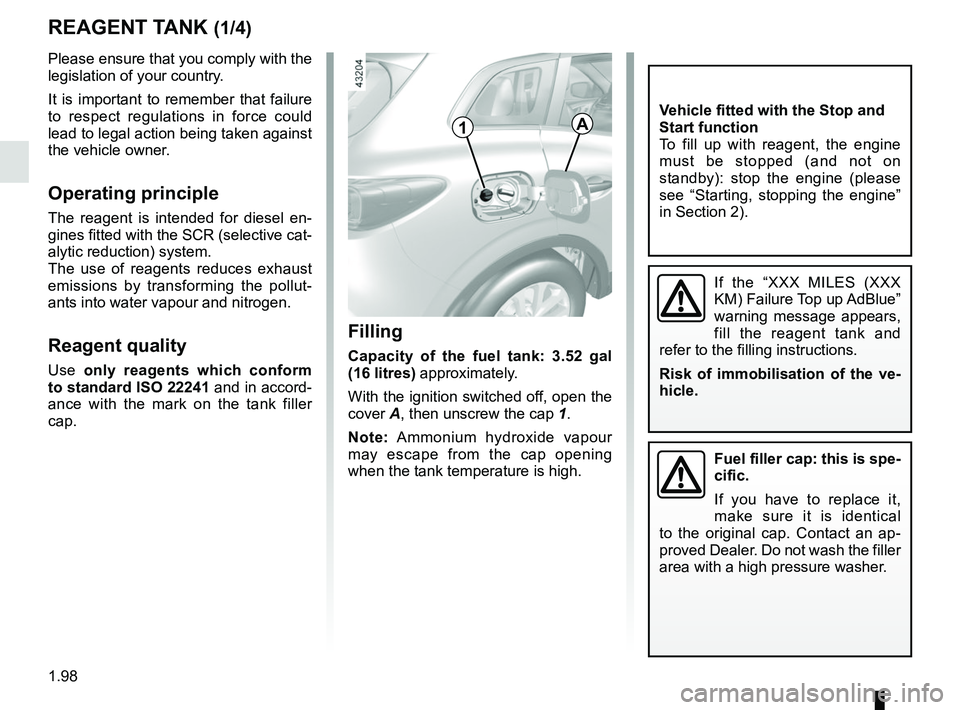
1.98
Filling
Capacity of the fuel tank: 3.52 gal
(16 litres) approximately.
With the ignition switched off, open the
cover A, then unscrew the cap 1.
Note: Ammonium hydroxide vapour
may escape from the cap opening
when the tank temperature is high.
Please ensure that you comply with the
legislation of your country.
It is important to remember that failure
to respect regulations in force could
lead to legal action being taken against
the vehicle owner.
Operating principle
The reagent is intended for diesel en-
gines fitted with the SCR (selective cat-
alytic reduction) system.
The use of reagents reduces exhaust
emissions by transforming the pollut-
ants into water vapour and nitrogen.
Reagent quality
Use
only reagents which conform
to standard ISO 22241 and in accord-
ance with the mark on the tank filler
cap.
REAGENT TANK (1/4)
A1
Fuel filler cap: this is spe-
cific.
If you have to replace it,
make sure it is identical
to the original cap. Contact an ap-
proved Dealer. Do not wash the filler
area with a high pressure washer.
Vehicle fitted with the Stop and
Start function
To fill up with reagent, the engine
must be stopped (and not on
standby): stop the engine (please
see “Starting, stopping the engine”
in Section 2).
If the “XXX MILES (XXX
KM) Failure Top up AdBlue”
warning message appears,
fill the reagent tank and
refer to the filling instructions.
Risk of immobilisation of the ve-
hicle.
Page 105 of 310
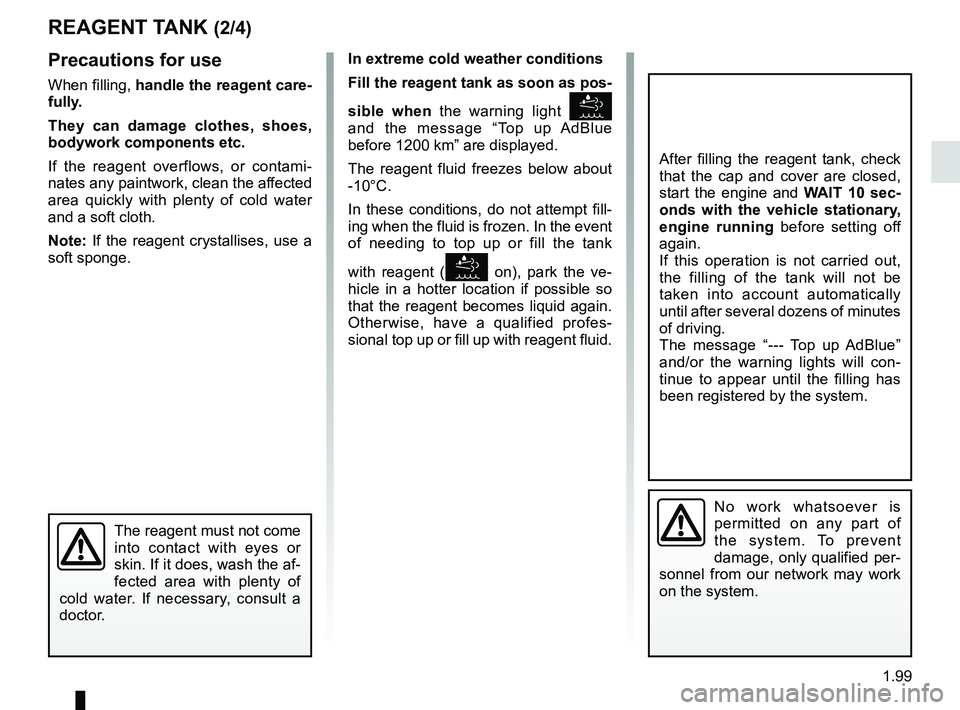
1.99
In extreme cold weather conditions
Fill the reagent tank as soon as pos-
sible when the warning light
and the message “Top up AdBlue
before 1200 km” are displayed.
The reagent fluid freezes below about
-10°C.
In these conditions, do not attempt fill-
ing when the fluid is frozen. In the event
of needing to top up or fill the tank
with reagent (
on), park the ve-
hicle in a hotter location if possible so
that the reagent becomes liquid again.
Otherwise, have a qualified profes-
sional top up or fill up with reagent fluid.
Precautions for use
When filling, handle the reagent care-
fully.
They can damage clothes, shoes,
bodywork components etc.
If the reagent overflows, or contami-
nates any paintwork, clean the affected
area quickly with plenty of cold water
and a soft cloth.
Note: If the reagent crystallises, use a
soft sponge.
The reagent must not come
into contact with eyes or
skin. If it does, wash the af-
fected area with plenty of
cold water. If necessary, consult a
doctor.
REAGENT TANK (2/4)
No work whatsoever is
permitted on any part of
the system. To prevent
damage, only qualified per-
sonnel from our network may work
on the system.
After filling the reagent tank, check
that the cap and cover are closed,
start the engine and WAIT 10 sec-
onds with the vehicle stationary,
engine running before setting off
again.
If this operation is not carried out,
the filling of the tank will not be
taken into account automatically
until after several dozens of minutes
of driving.
The message “--- Top up AdBlue”
and/or the warning lights will con-
tinue to appear until the filling has
been registered by the system.
Page 106 of 310
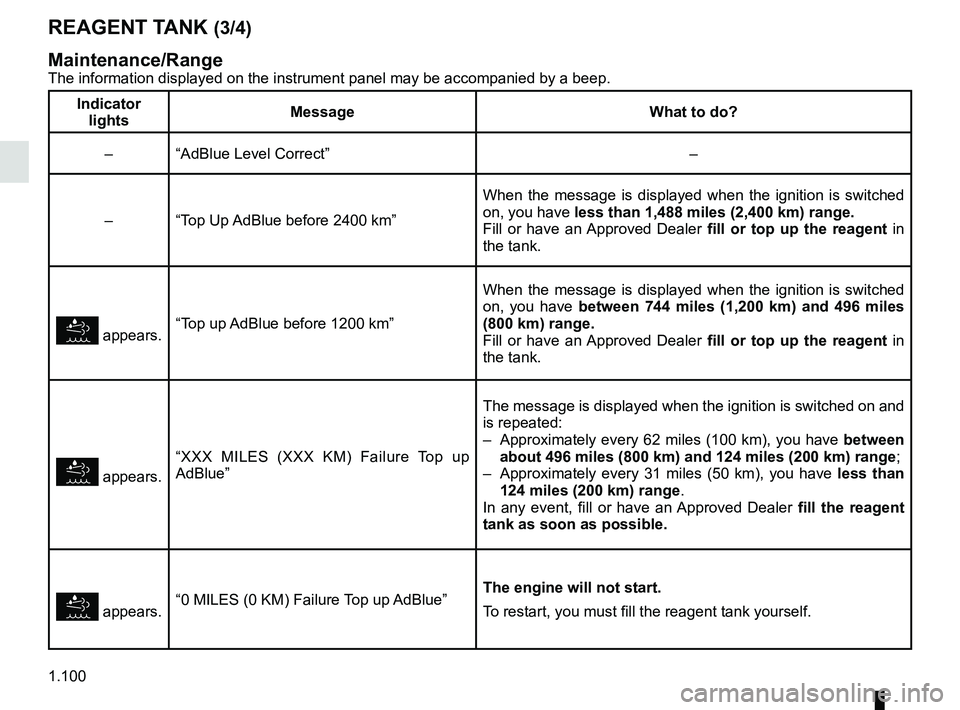
1.100
REAGENT TANK (3/4)
Maintenance/Range
The information displayed on the instrument panel may be accompanied by \
a beep.
Indicator lights Message What to do?
– “AdBlue Level Correct” –
– “Top Up AdBlue before 2400 km” When the message is displayed when the ignition is switched
on, you have less than 1,488 miles (2,400 km) range.
Fill or have an Approved Dealer
fill or top up the reagent in
the tank.
appears. “Top up AdBlue before 1200 km” When the message is displayed when the ignition is switched
on, you have
between 744 miles (1,200 km) and 496 miles
(800 km) range.
Fill or have an Approved Dealer fill or top up the reagent in
the tank.
appears. “XXX MILES (XXX KM) Failure Top up
AdBlue” The message is displayed when the ignition is switched on and
is repeated:
– Approximately every 62 miles (100 km), you have
between
about 496 miles (800 km) and 124 miles (200 km) range ;
– Approximately every 31 miles (50 km), you have less than
124 miles (200 km) range .
In any event, fill or have an Approved Dealer fill the reagent
tank as soon as possible.
appears. “0 MILES (0 KM) Failure Top up AdBlue” The engine will not start.
To restart, you must fill the reagent tank yourself.
Page 107 of 310
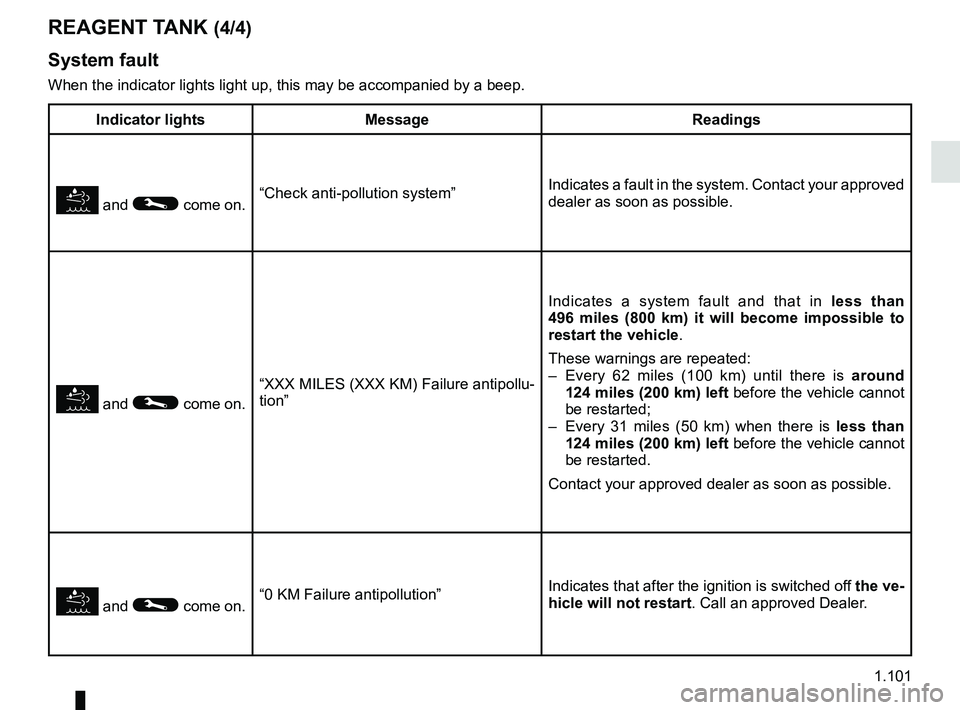
1.101
REAGENT TANK (4/4)
System fault
When the indicator lights light up, this may be accompanied by a beep.
Indicator lights Message Readings
and © come on.“Check anti-pollution system”
Indicates a fault in the system. Contact your approved
dealer as soon as possible.
and © come on.“XXX MILES (XXX KM) Failure antipollu-
tion” Indicates a system fault and that in
less than
496 miles (800 km) it will become impossible to
restart the vehicle .
These warnings are repeated:
– Every 62 miles (100 km) until there is around
124 miles (200 km) left before the vehicle cannot
be restarted;
– Every 31 miles (50 km) when there is less than 124 miles (200 km) left before the vehicle cannot
be restarted.
Contact your approved dealer as soon as possible.
and © come on. “0 KM Failure antipollution”
Indicates that after the ignition is switched off the ve-
hicle will not restart
. Call an approved Dealer.
Page 108 of 310
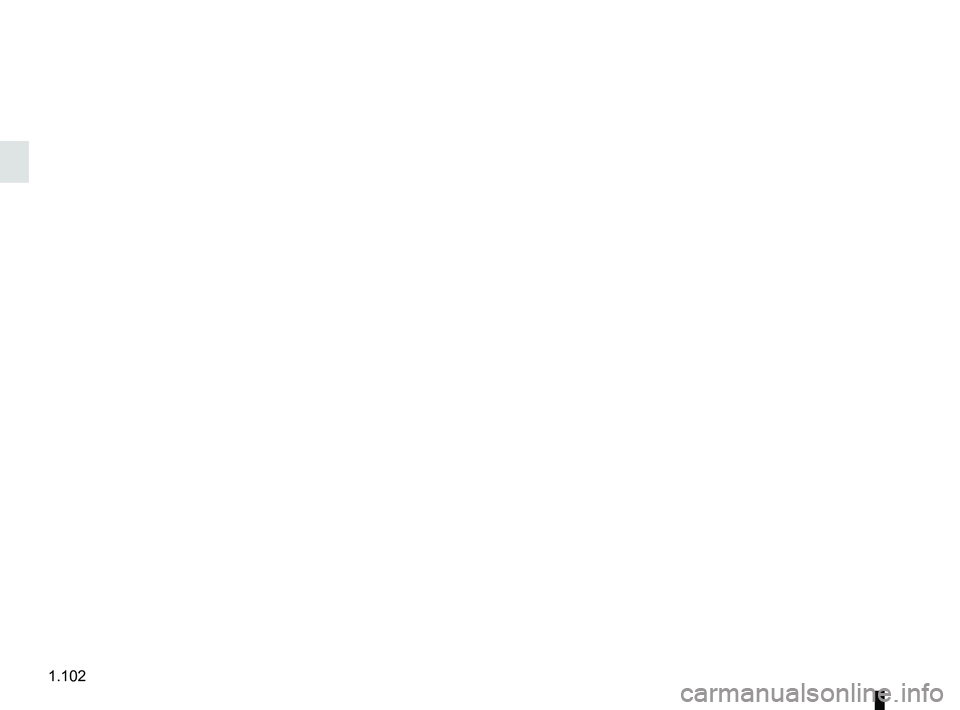
1.102
Page 109 of 310
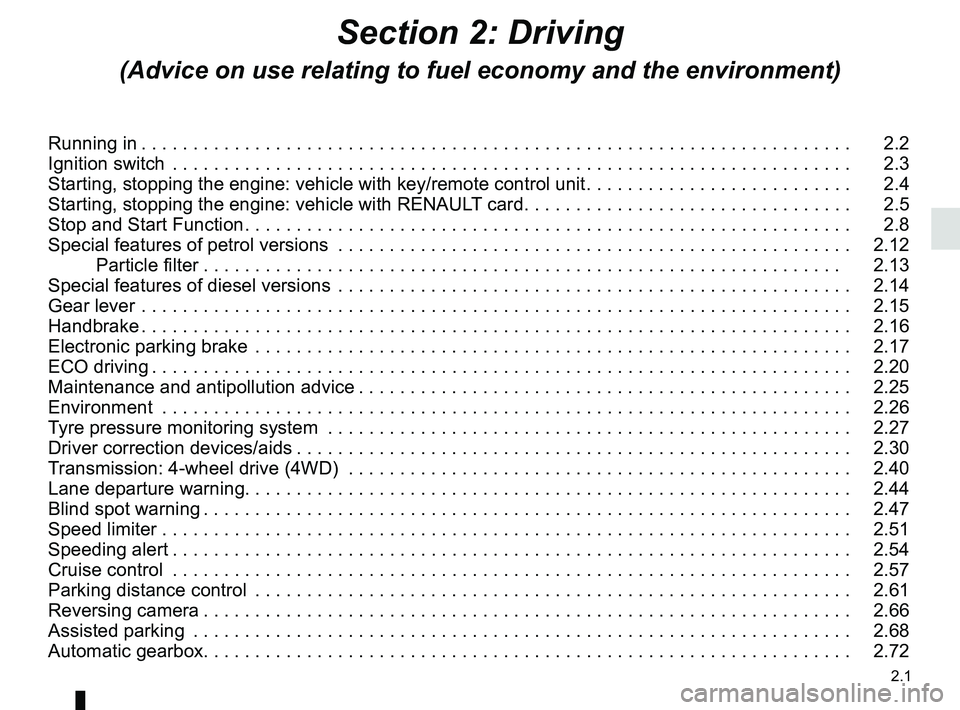
2.1
Section 2: Driving
(Advice on use relating to fuel economy and the environment)
Running in . . . . . . . . . . . . . . . . . . . . . . . . . . . . . . . . . . . . \
. . . . . . . . . . . . . . . . . . . . . . . . . . . . . . . . . 2.2
Ignition switch . . . . . . . . . . . . . . . . . . . . . . . . . . . . . . . . . . . .\
. . . . . . . . . . . . . . . . . . . . . . . . . . . . . . 2.3
Starting, stopping the engine: vehicle with key/remote control unit . . . . . . . . . . . . . . . . . . . . . . . . . . 2.4
Starting, stopping the engine: vehicle with RENAULT card . . . . . . . . . . . . . . . . . . . . . . . . . . . . . . . . 2.5
Stop and Start Function . . . . . . . . . . . . . . . . . . . . . . . . . . . . . . . . . . . . \
. . . . . . . . . . . . . . . . . . . . . . . 2.8
Special features of petrol versions . . . . . . . . . . . . . . . . . . . . . . . . . . . . . . . . . . . .\
. . . . . . . . . . . . . . 2.12Particle filter . . . . . . . . . . . . . . . . . . . . . . . . . . . . . . . . . . . . \
. . . . . . . . . . . . . . . . . . . . . . . . . . 2.13
Special features of diesel versions . . . . . . . . . . . . . . . . . . . . . . . . . . . . . . . . . . . .\
. . . . . . . . . . . . . . 2.14
Gear lever . . . . . . . . . . . . . . . . . . . . . . . . . . . . . . . . . . . .\
. . . . . . . . . . . . . . . . . . . . . . . . . . . . . . . . . 2.15
Handbrake . . . . . . . . . . . . . . . . . . . . . . . . . . . . . . . . . . . . \
. . . . . . . . . . . . . . . . . . . . . . . . . . . . . . . . . 2.16
Electronic parking brake . . . . . . . . . . . . . . . . . . . . . . . . . . . . . . . . . . . .\
. . . . . . . . . . . . . . . . . . . . . . 2.17
ECO driving . . . . . . . . . . . . . . . . . . . . . . . . . . . . . . . . . . . . \
. . . . . . . . . . . . . . . . . . . . . . . . . . . . . . . . 2.20
Maintenance and antipollution advice . . . . . . . . . . . . . . . . . . . . . . . . . . . . . . . . . . . . \
. . . . . . . . . . . . 2.25
Environment . . . . . . . . . . . . . . . . . . . . . . . . . . . . . . . . . . . .\
. . . . . . . . . . . . . . . . . . . . . . . . . . . . . . . 2.26
Tyre pressure monitoring system . . . . . . . . . . . . . . . . . . . . . . . . . . . . . . . . . . . .\
. . . . . . . . . . . . . . . 2.27
Driver correction devices/aids . . . . . . . . . . . . . . . . . . . . . . . . . . . . . . . . . . . . \
. . . . . . . . . . . . . . . . . . 2.30
Transmission: 4-wheel drive (4WD) . . . . . . . . . . . . . . . . . . . . . . . . . . . . . . . . . . . .\
. . . . . . . . . . . . . 2.40
Lane departure warning. . . . . . . . . . . . . . . . . . . . . . . . . . . . . . . . . . . . \
. . . . . . . . . . . . . . . . . . . . . . . 2.44
Blind spot warning . . . . . . . . . . . . . . . . . . . . . . . . . . . . . . . . . . . . \
. . . . . . . . . . . . . . . . . . . . . . . . . . . 2.47
Speed limiter . . . . . . . . . . . . . . . . . . . . . . . . . . . . . . . . . . . .\
. . . . . . . . . . . . . . . . . . . . . . . . . . . . . . . 2.51
Speeding alert . . . . . . . . . . . . . . . . . . . . . . . . . . . . . . . . . . . . \
. . . . . . . . . . . . . . . . . . . . . . . . . . . . . . 2.54
Cruise control . . . . . . . . . . . . . . . . . . . . . . . . . . . . . . . . . . . .\
. . . . . . . . . . . . . . . . . . . . . . . . . . . . . . 2.57
Parking distance control . . . . . . . . . . . . . . . . . . . . . . . . . . . . . . . . . . . .\
. . . . . . . . . . . . . . . . . . . . . . 2.61
Reversing camera . . . . . . . . . . . . . . . . . . . . . . . . . . . . . . . . . . . . \
. . . . . . . . . . . . . . . . . . . . . . . . . . . 2.66
Assisted parking . . . . . . . . . . . . . . . . . . . . . . . . . . . . . . . . . . . .\
. . . . . . . . . . . . . . . . . . . . . . . . . . . . 2.68
Automatic gearbox. . . . . . . . . . . . . . . . . . . . . . . . . . . . . . . . . . . . \
. . . . . . . . . . . . . . . . . . . . . . . . . . . 2.72
Page 110 of 310
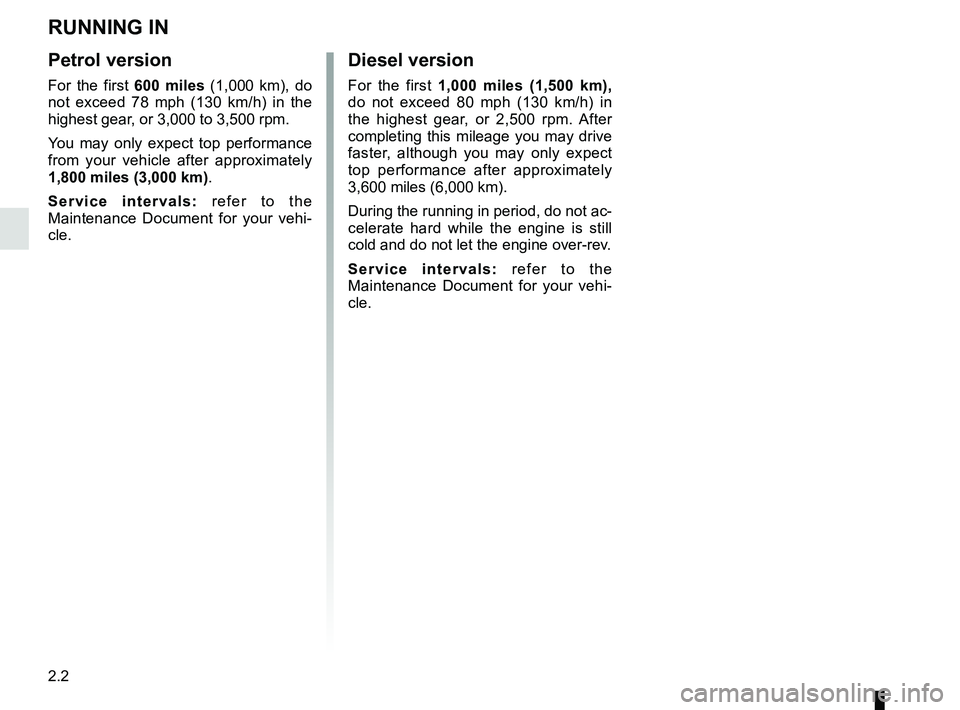
2.2
RUNNING IN
Petrol version
For the first 600 miles (1,000 km), do
not exceed 78 mph (130 km/h) in the
highest gear, or 3,000 to 3,500 rpm.
You may only expect top performance
from your vehicle after approximately
1,800 miles (3,000 km) .
Service intervals: refer to the
Maintenance Document for your vehi-
cle.
Diesel version
For the first 1,000 miles (1,500 km),
do not exceed 80 mph (130 km/h) in
the highest gear, or 2,500 rpm. After
completing this mileage you may drive
faster, although you may only expect
top performance after approximately
3,600 miles (6,000 km).
During the running in period, do not ac-
celerate hard while the engine is still
cold and do not let the engine over-rev.
Service intervals: refer to the
Maintenance Document for your vehi-
cle.